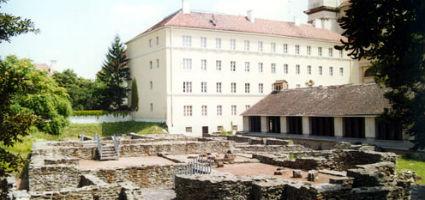2024. April 26. Friday
István Járdányi Paulovics Ruin Garden - Szombathely
 |
Address: 9700, Szombathely Mindszenty tér 1.
Phone number: (94) 313-369, (94) 501-948
E-mail: info@savariamuseum.hu
Opening hours: 07.04-31.05.: Tue-Sun 10-17; 01.06-31.08.: Tue-Sun 10-19; 01.09-30.10.: Tue-Sun 10-17
|
The so-called Püspökkert stands out as a green isle in the center of the town, where excavations discovered significant groups of buildings in the Colonia Claudia Savaria established in around 50 AD.
The present ruin garden expounds far beyond the border of the former bishop garden. In the beginning of the 4th century a big palace was erected for the welcoming of the emperor's suite. Some regulations were written here in the times of Constantin I, Constantius II and Valentinianus.
The foundation of the palace was possibly 200 times 200 metres. At present we only know the Western and Eastern area of the gigantic building, for the medieval round castle and the girls' school were erected on the same site.
The assembly hall of 50X17metres stands out of the palace. The floor of this hall was ornamented by mosaics, This used to be the largest mosaic surface of Pannonia province. Possibly at the end of the 4th century an octagonal bath house was built. The outer wall of the bath house was decorated by paintings. In the North-West corner the basements of the Mercurius sanctuary were excavated.
Parallel to the previous road section a significant crossing was built in the 3rd century,outside the former town walls. Basalt covered sections of the road have been preserved for our days. There was a custom house at the cross roads. Shops and potteries were standing by the side of the road. A permanent exhibition entitled Potters of Savaria is connected to these places.
The present ruin garden expounds far beyond the border of the former bishop garden. In the beginning of the 4th century a big palace was erected for the welcoming of the emperor's suite. Some regulations were written here in the times of Constantin I, Constantius II and Valentinianus.
The foundation of the palace was possibly 200 times 200 metres. At present we only know the Western and Eastern area of the gigantic building, for the medieval round castle and the girls' school were erected on the same site.
The assembly hall of 50X17metres stands out of the palace. The floor of this hall was ornamented by mosaics, This used to be the largest mosaic surface of Pannonia province. Possibly at the end of the 4th century an octagonal bath house was built. The outer wall of the bath house was decorated by paintings. In the North-West corner the basements of the Mercurius sanctuary were excavated.
Parallel to the previous road section a significant crossing was built in the 3rd century,outside the former town walls. Basalt covered sections of the road have been preserved for our days. There was a custom house at the cross roads. Shops and potteries were standing by the side of the road. A permanent exhibition entitled Potters of Savaria is connected to these places.
|
Permanent exhibitions
|
||